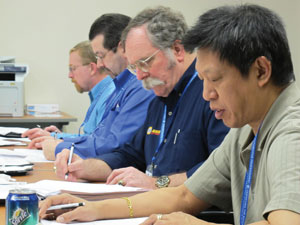It gets taken every year — the ASE P2. And every year, counterpros around the country study up on store operations questions, parts predicaments and some math homework to take the test and hopefully, earn their blue seal. But come test day, all those P2 questions don’t just materialize out of thin air.
The job of writing questions is bestowed upon a select group of parts industry professionals who have been invited by ASE to help write the questions. Question-writing workshops have been held in other cities in years’ past, but this year’s session was held in mid-February at ASE’s headquarters in Leesburg, Va. I was fortunate enough to be invited by David Milne, the ASE executive in charge of running the question-writing sessions, to sit in, observe and interact with those writing questions. Among the question-writers this year were Thomas Dayton, who garnered Counterman’s Counter Professional of the Year Award in 2009; Craig Bradley, who received the award in 2008; and Jerry Ives, who received the award in 2002.
 It didn’t take long to comprehend one very salient point: Writing test questions isn’t as easy as it might at first sound. It is serious business. After Milne provided an overview of why everyone was there and the procedures that must be followed to write the test questions, the group hashed out the finer points of the task list. The task list accompanies each P2 study guide and reviews for test-takers the tasks which they must understand and will be tested on.
It didn’t take long to comprehend one very salient point: Writing test questions isn’t as easy as it might at first sound. It is serious business. After Milne provided an overview of why everyone was there and the procedures that must be followed to write the test questions, the group hashed out the finer points of the task list. The task list accompanies each P2 study guide and reviews for test-takers the tasks which they must understand and will be tested on.
For example, in the most recent study guide booklet, the task list explained there would be 10 questions under “general operations.” The tasks included “calculate discounts, selling prices, percentages and pro-rated warranties.” Or under the suspension and steering section, there would be three questions, and one of those tasks could include “identify component function and common reasons for replacement.”
Question-writing is pretty hush-hush. In fact, all workshop attendees must sign a non-disclosure agreement. (I told you this was serious stuff). And there’s good reason for it. Confidentiality protects the validity and security of the test. If someone were to leak the test questions, it could wreak havoc for just about every test-taker out there.
So without revealing too much information, the group decides how to phrase questions and whether certain wrong answers (or distractors) are plausible enough to draw the attention of someone who is less than knowledgeable on the topic. Sometimes, a list of questions from previous sessions just needs a tweak here or there to satisfy test requirements and they’re good to go on to the next step — being embedded into a live test as an unscored item to see how they perform and to decide if they’ll be used in the actual test as a scored item.
After reviewing the task list, Milne let the group loose several times on writing questions, each time for about an hour. It’s generally kept to an hour to prevent burnout and keep focus. Attendees this year were given a tour of the test assembly room, where the test is actually compiled.
My visit to ASE was timely: 2011 will be the final year for written tests. Last year, ASE signed an agreement with a company named Prometric to deliver enhanced computer-based testing, starting in 2012, that will be available eight months of the year.
My thanks to David Milne and everyone who attended the question-writing session this year, as well as to the very professional ASE staff who makes everyone feel welcome and provided anything anyone would need to have a successful ASE question-writing session.













